Real Madrid looked to return to winning ways in La Liga when they went to the Coliseum Alfonso Perez to fight for three points against Getafe. Zinedine Zidane’s side are second in the table, however, and with only two points separating them and Barcelona, this was a must-win game for Zidane’s side.
On the other hand, Jose Bordalas and his Getafe have enjoyed a strong campaign which has seen them sitting midtable in La Liga with 30 points to show from their 18 matches. With Getafe being just two points off fourth-placed Atletico Madrid, this game presented a huge chance for Getafe to disrupt the hegemony of the Big Three.
In this tactical analysis, we will analyse the tactics of Real Madrid and Getafe. In addition, we will show an analysis of exactly how and why Madrid put three goals past their hosts.
Lineups
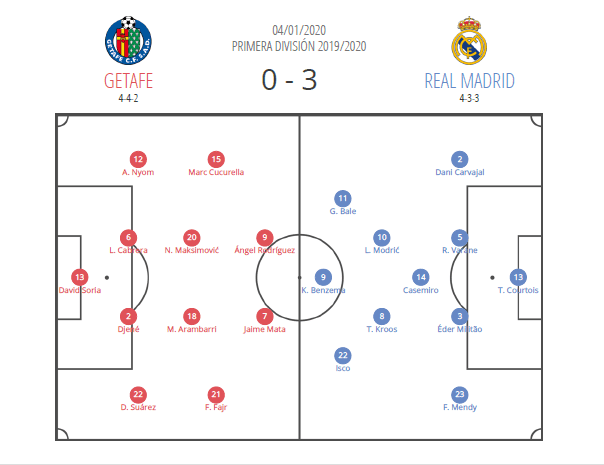
Bordalas made two changes to the side that lost 1-0 to Villareal. Wide midfielder Francisco Portillo was replaced by Fayçal Fajr. Finally, forward Jorge Molina Vidal was replaced by Ángel Rodríguez. As such, with all set, Bordalas lined up his side in a 4-2-2
Zidane made four changes to the Los Blancos side that drew to Atletico Bilbao. Central defender Sergio Ramos was replaced by Raphaël Varane, and central defensive midfielder Fede Valverde was replaced by Casemiro. Finally, forwards Vinícius Júnior and Rodrygo were replaced by Isco and Gareth Bale. With these changes being made, Zidane chose a 4-3-3 structure.
Getafe’s pressing frustrates Madrid in the first half
Right off the start, Bordalas’ men set the intensity and tone of the match. Engaging in a high and aggressive pressing scheme, Getafe frustrated Real Madrid in the first half.
Lining up as a 4-4-2 on paper, Getafe morphed into a fluid 4-1-4-1 pressing structure that worked to put intense pressure on the backline and midfield of Los Blancos. Los Blancos, like teams all over the world, have adopted a possession-based system that involves intricate buildup to launch attacks.
Pressing this structure would allow Getafe to find gaps and holes in Madrid’s formations and more importantly, restrict them from getting forward very much.
To start of their press, they started in the 4-1-4-1 formation with one of the strikers dropping into the midfield line and one of the midfielders temporarily playing the role of a central defensive midfielder. This slight change had various benefits when Los Azulones pressed.
First of all, it contained Real Madrid’s midfield to a large degree. Whenever Getafe pressed Madrid in the buildup, Madrid would separate their two centre-backs and advance their full-backs. Additionally, a central defensive midfielder would occupy the space between the centre-backs.
As such, Madrid would have five players in the middle of the pitch. The 4-1-4-1 from Getafe allowed Bordalas to match those five players as the midfield block of four would man-mark the two full-backs and two central midfielders. The holding midfielder from Los Azulones would then be free to pick up the third midfielder if he dropped deep.

Here four Getafe midfielders man-mark Real Madrid’s two full-backs whilst also controlling the two central midfielders. The deepest Getafe midfielder also man-marks a Real Madrid player while the lone forward up top applies pressure to his centre-back.
As one can see in this structure, all progressive passing options are closely monitored and controlled to a great extent. The only free player is the other centre-back for Real Madrid. Pressing like this severely restricted Madrid’s buildup and attacking play.
On the front line, Madrid’s three-man attack was now in a numerically inferior position as the four-man backline made a 4v3 situation. This meant that any movements from the forwards to drop deep and help would be diluted as one of the members from the backline could simply follow. As such, the 4-1-4-1 from Getafe served as a containing press – a press designed to force play in certain areas where Madrid did not have a lot of passing options.
The only free player during this scheme was the second centre-back. Since Getafe were pressing the rest of the team, passes to other players were risky and were played back to the centre-backs.
The natural option from there was to pass to the second centre-back in attempts to find some complacency from the Getafe players and as such, find a passing option. This is exactly what Getafe wanted as this triggered them to switch from their 4-1-4-1 press to a 4-4-2 press.
Now, both centre-backs were being pressed with intensity. While Madrid did have a free midfielder in this process, the timing and the intensity of the press often made it hard for Los Blancos to find the free man.

Now Getafe are pressing in a 4-4-2 pressing scheme. Three Real Madrid players are covershadowed – shown in the blue triangles. This means passing options to those players are extremely limited. The second forward is now making a curved run to press the ball recipient.
Casemiro, while free for a small time, is being pressed by the farthest forward who is making a run – shown in black. The only free player is shown in red. He has ample space around him however Getafe’s pressing intensity and timing means Madrid are not able to reach the free man.
Moreover, the distance between the ball recipient and the free man is too large to make up with a ground pass. The time needed for a chipped pass time is too long and as such, by the time it reaches its destination, Getafe will already have a person near the free man. As one can see, once again, Getafe have made attacking play extremely restrictive.
As such a lot of times, the centre-backs would either play it long or play it back to goalkeeper Thibaut Courtois who would follow suit. The times where Madrid did try to navigate Getafe’s labyrinth, they were only successful in stringing a few combinations before the press forced a misplaced pass or dispossession.
The press worked to perfection as Madrid were denied any sight of goal. In the first half, Madrid recorded an xG of 0.11 – a number which infers that Madrid did not even touch the goal confidently. This low statistic should have meant that Getafe make some headway. However, a lucky set-piece situation meant that Varane nodded in the first goal of Madrid.
Heading into the second half, Madrid knew that the lead was meagre at best and that the tide could turn at any moment. With Getafe continually attacking through a combination of set-pieces, crossing, and direct shots, Courtois repeatedly made saves that would have gone in on any normal day.
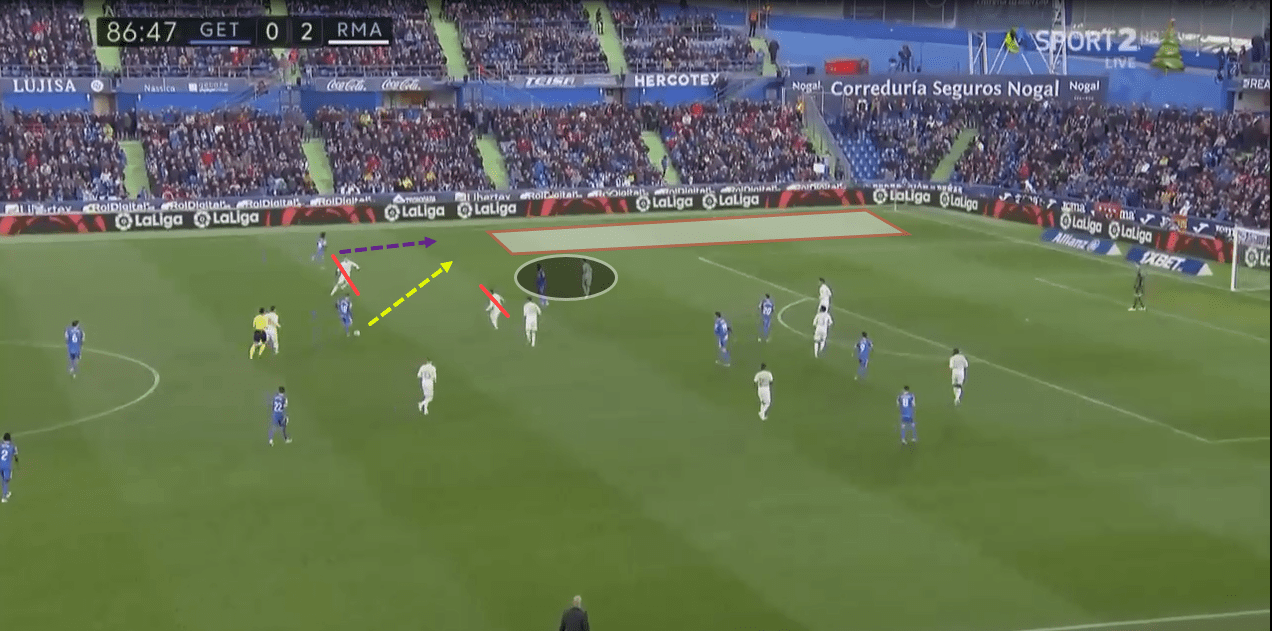
Real Madrid are loose defensively which nicely opens up a hole from where Getafe can go from the central space to the wing space. Moreover, the presence of an attacker, shown in black, pins the accompanying Real Madrid defender opening up the wing for Getafe to attack and cross.
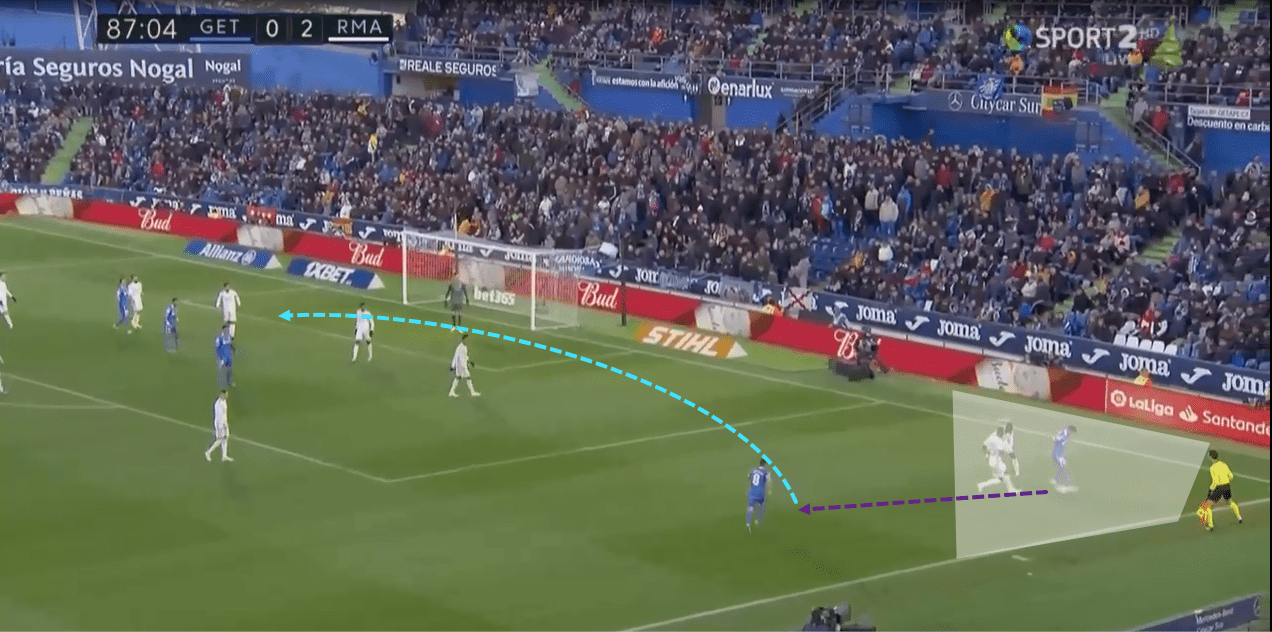
Here is another example of Getafe’s attacking plays. They want to create a numerically equal situation so that then they can use one of the players to attract the attention of the Madrid defenders. This creates the space for the other and allows them to cross as shown here.
Madrid’s midfield offers solution against Getafe press
With an overrun midfield and an increasingly frantic Getafe, Zidane had to find the solution quick and find he did.
Getafe’s press, just like any other press, is not bullet-proof and suffers from common factors such as fatigue and complacency. The weakness for Los Azulones was in their transition from the 4-1-4-1 to the 4-4-2. When doing so, one of the members had to leave the midfield line to be part of the attacking line.
When doing such, space would be created in the middle. If Madrid could play in this space, they would attract Getafe’s formation inwards allowing space to be created behind the midfield line.
With more space opening, Zidane deployed the new principle of play by calling Isco to drop deep and form a midfield diamond with Luka Modrić, Toni Kroos, and Casemiro.
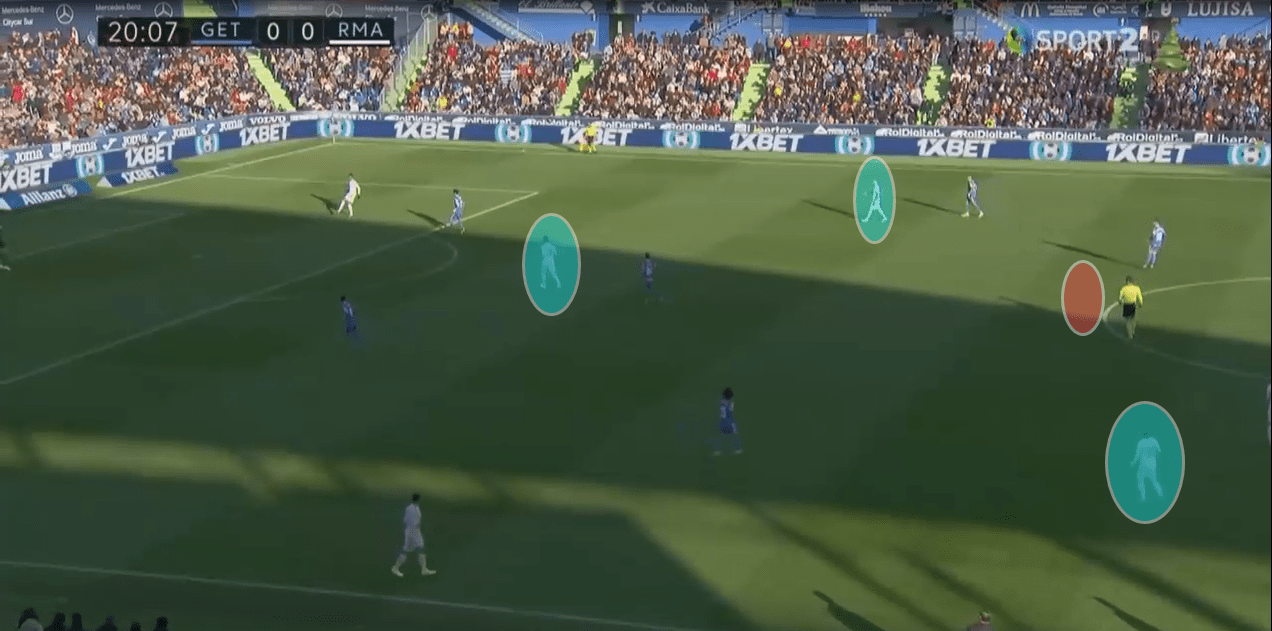
Here are the typical midfield positions from Los Blancos. The three midfielders of Modrić, Casemiro, and Kroos, are shown in blue. However, they are far too apart for any meaningful play to happen. Moreover, Madrid are matched in midfield and the absence of Isco – who should be occupying the position in red – further hurts their buildup and attacking play.

Now here is the change from Zidane. The four midfielders are now much closer – assembling in a diamond. Their proximity permits meaningful interchanges which in turn benefits Madrid’s attacking play.
The quartet are extremely technical and are press-resistant to a large degree. As such, the four of them would play closer and as such, whenever Getafe pressed the ball and created space in the middle, the four of them would intricately combine to draw the formation inwards.
This now created space behind the midfield line and the likes of Karim Benzema and Bale could finally breathe and start making space for themselves.
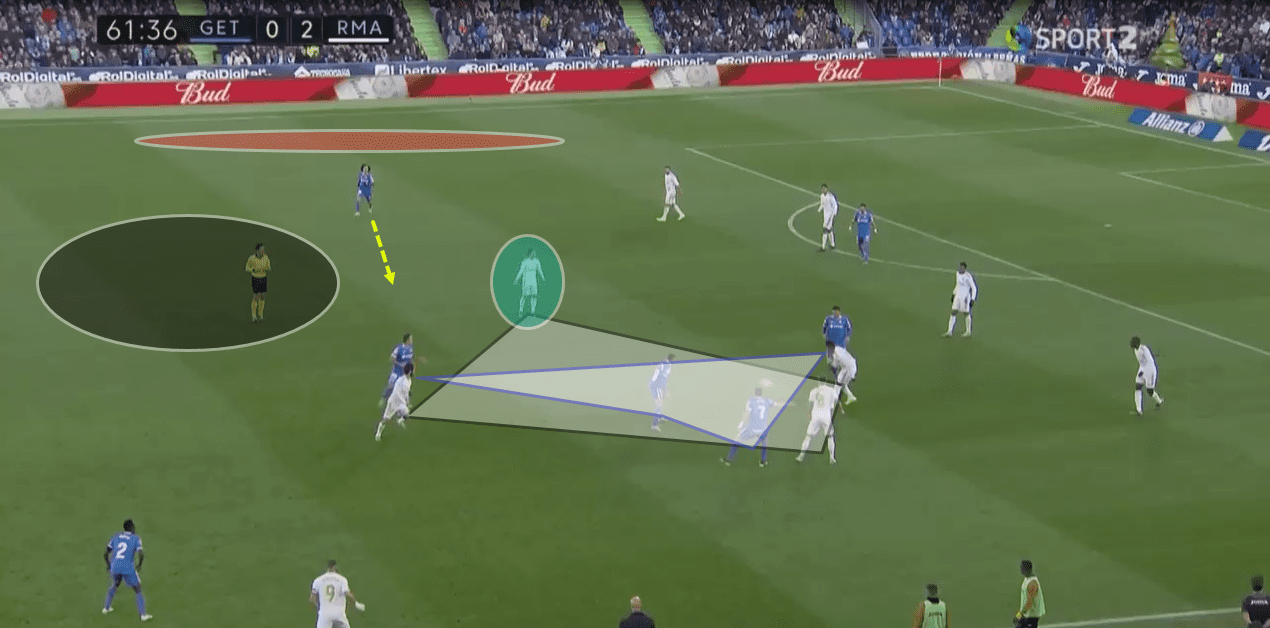
Here we see the diamond of Madrid has found some space in the middle. As such, they start playing between themselves which draws in the normally disciplined Getafe midfield line. With the line collapsing inwards, Madrid have now created space in front and on the wings – shown in black and red.
As another Getafe player comes inward – shown in yellow – Modrić acts a conductor for play to go from the congestion to free space. In essence, he can release the ball to the forwards up ahead.
In good fortune, Madrid got another helping hand. In the 53rd minute, Kroos and Varane combined to create the second goal as Varane headed another goal in the net. With this second goal and a new principle of play, Madrid started to have success.
As a result of the second goal, Getafe became more open in their attempts to find the goals. Compared to the first half where they had 0.48 attacks per minute, they recorded 0.63 attacks per minute in the second half.
In doing so, their narrow formation and defensive structure became open as they, at times, rushed to get the ball. With more holes popping up, the quartet started finding more success.
Even after the substitutions of Isco and Kroos for Vinicius Junior and Fede Valverde, the strategy of intricate play in space remained the same. As the game went on, it was clear that Valverde’s substitution was put in place to create a low-block.
Modrić now dropped with Casemiro to create a solid pivot in front of the defensive line. Valverde would then function as the bursting midfielder.
Even with this new structure, the principle of intricate play succeeded with greater end product due to the substitute Valverde’s tenacity to progress the ball and break lines with a stronger presence than Isco.
With Junior, a rapid youngster, at left-wing, the space for Madrid had more potential to be destructive as Junior’s pace and trickery allowed Madrid to strongly attack Getafe’s defensive line.
The tactics from Zidane worked as Madrid’s xG rose remarkably to a 1.04 with the likes of Bale and Modrić contributing an xG of 0.33 and 0.36 respectively. Madrid now had their key players contributing significantly to the attack.
Fede Valverde shows his importance and quality
A key player in the match was youngster Fede Valverde. The Uruguayan midfielder has been regularly playing for Madrid and has quickly become a key cog in Zidane’s Los Blancos.
The traits in Valverde are easy to spot. Tall and strong, Valverde is very comfortable with possession and at playing those creative passes. This makes him a great choice for the central defensive midfielder position.
On the other hand, his comfort with possession is complemented with a swashbuckling stride that quickly covers the ground and leaves players in the dust.
It was this other side to the Uruguayan that Zidane utilized against Getafe. Setting him up alongside Modrić and in behind of Benzema (who was later substituted for Luka Jović), Junior, and Bale, Zidane set Valverde as the player to add the creative spark in the midfield.
Zidane had tried this in the first half with Isco who largely disappointed in his creative and attacking plays. With a negligible xA, Isco only made two accurate forward passes and four progressive passes. For a touted creative midfielder, the game was clearly not Isco’s day.
Valverde shone with a brighter light and then some. Contributing to an xA of 0.56, the highest in the Madrid squad while only playing 26 minutes, Valverde was a breath of fresh air for Madrid.
Not only did he provide the creativity, but he also matched Isco’s attacking-wise passing statistics in less time. Valverde made one accurate through ball, two deep completions, and two key passes.
In context, only Kroos made the same amount of accurate through balls while Valverde recorded the highest number of key passes and deep completions in the whole game – this includes Getafe and Madrid players.
Clearly, Valverde added the creative light onto the dark pitch and it was no coincidence that Madrid almost scored their third in the 92nd minute after a brilliant through ball from Valverde.
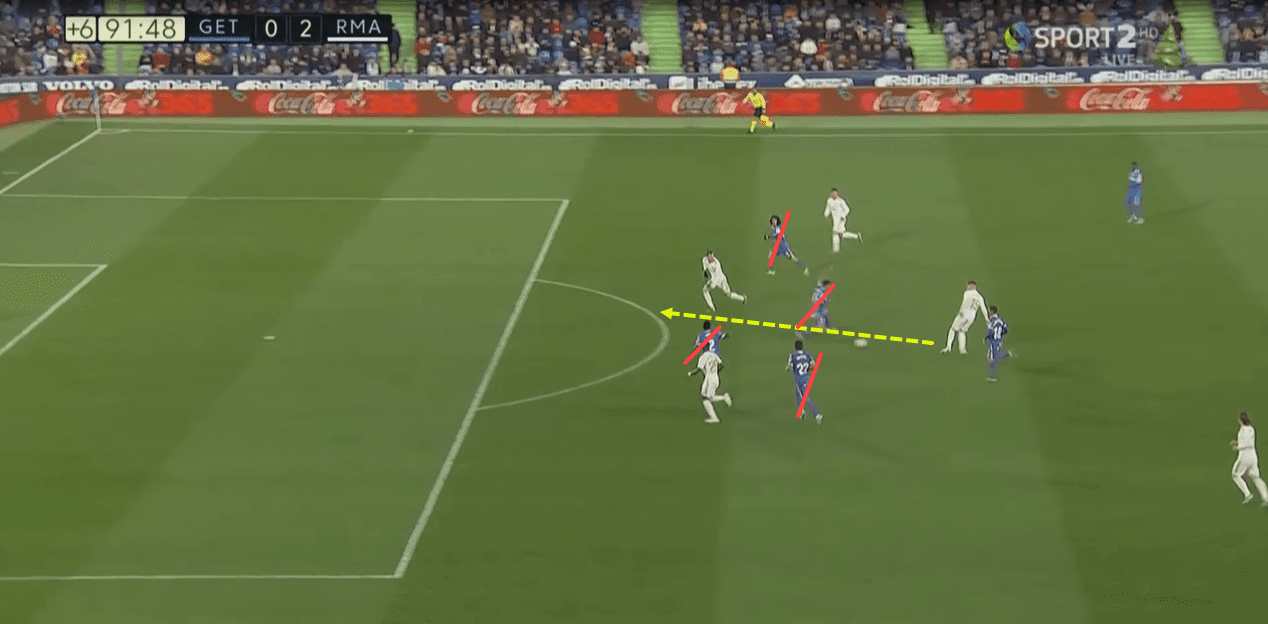
Here Valverde spots Bale’s run early on and threads a through ball bypassing a block of Getafe players and setting up Bale. This sort of incision was missed by Madrid in the first half.
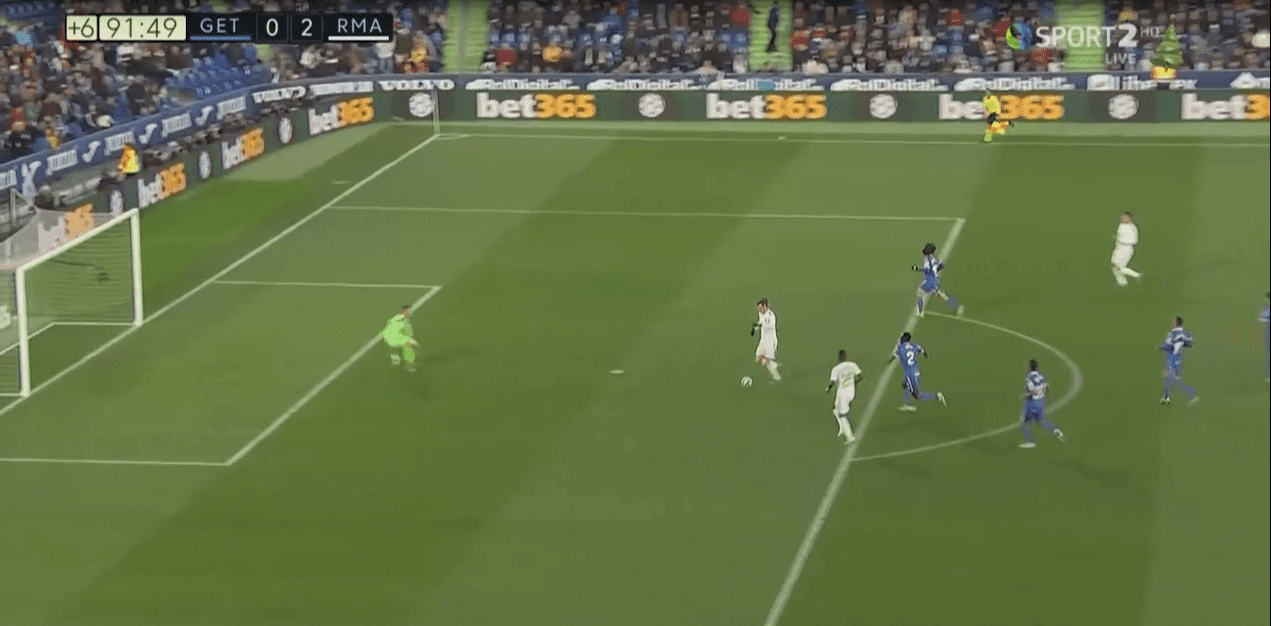
Now Bale is in a 1v1 situation and knowing his talents, should really have put this away. However, through balls like these are a testament to the skill that Valverde.
Valverde’s positioning and pace were what allowed a Getafe dispossession to turn into a lethal Real Madrid counterattack. The Uruguayan would single-handedly start the attack and then assist the goal scorer Luka Modrić for Madrid to score the third goal.
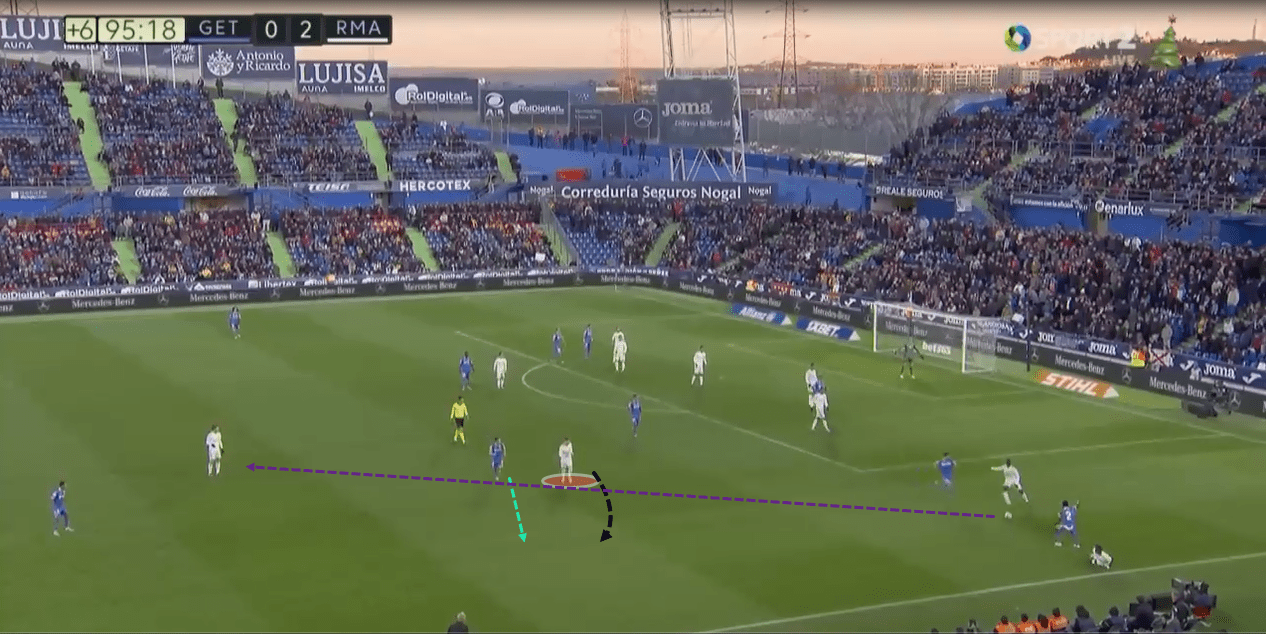
Here Valverde recognizes he is being man-marked and doesn’t want to impede the counter-attack. As such, he moves to the wing to open the passing lane to the central, free Real Madrid player.
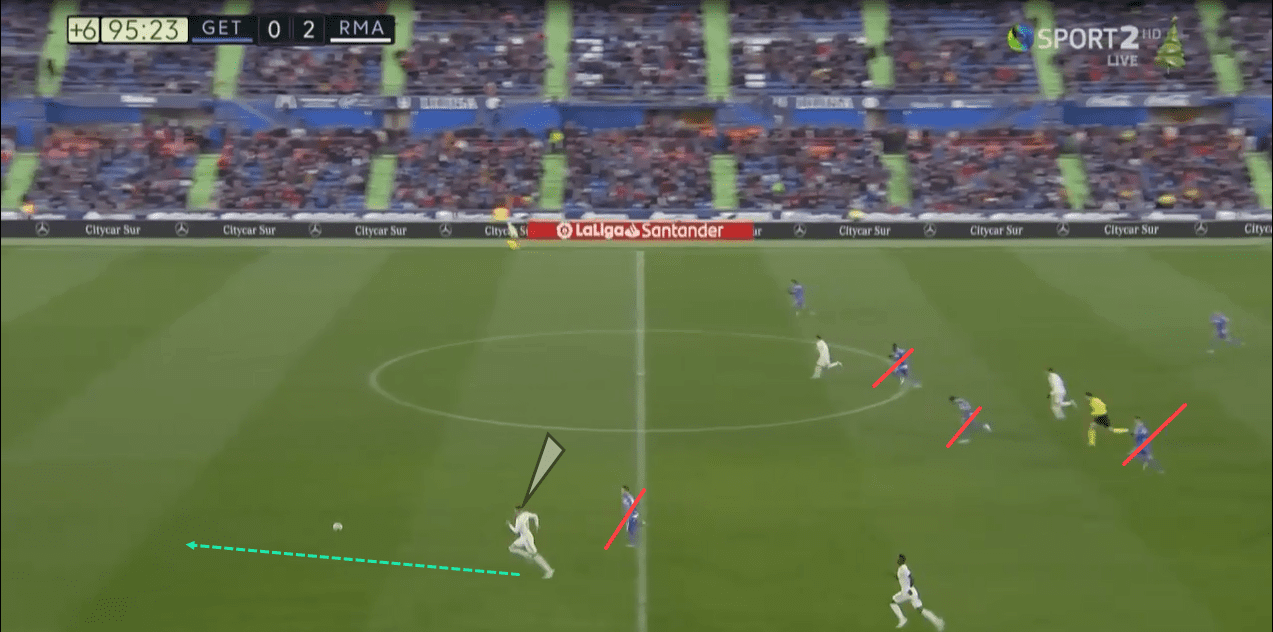
In one pass, Valverde has now bypassed his marker by a distance and is running with the ball. While many players would keep going, Valverde has a glance to the right – shown with the white triangle – to see that Modrić is keeping pace with him.
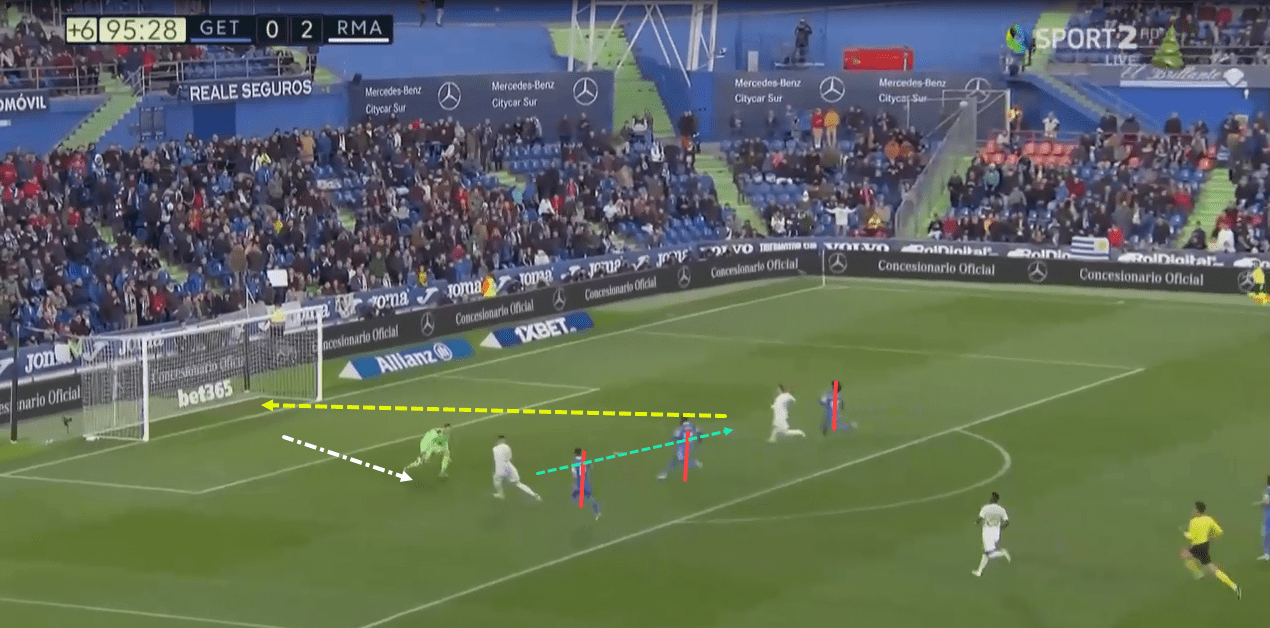
His awareness allows him to give the pass to Modrić at the right time. Valverde dribbles up till the point that the Getafe goalkeeper comes up and then passes to Modrić. This allows him to bypass the whole block of Getafe players – including the goalkeeper – and the Croatian midfielder is able to score the third goal.
Conclusion
This win is a huge boost for Zidane’s side. Madrid now sit level with Barcelona, ranking second only due to goal difference of two goals. With this crucial win, the title race in the La Liga is now heating up and Barcelona will definitely feel the heat as the Blancos from Bernabeau increase their hunt for the La Liga title.
For Getafe, it will be a hard-felt loss. Having dominated Madrid for large parts of the game, they will feel wronged with this loss. However, all hope is not lost. They still 7th and only one point separates them from fifth place. Bordalas, however, will feel a slight respite in the loss as it would have provided Los Azulones with the perfect platform for the shot at Champions League spot.

If you love tactical analysis, then you’ll love the digital magazines from totalfootballanalysis.com – a guaranteed 100+ pages of pure tactical analysis covering topics from the Premier League, Serie A, La Liga, Bundesliga and many, many more. Buy your copy of the December issue for just ₤4.99 here




Comments